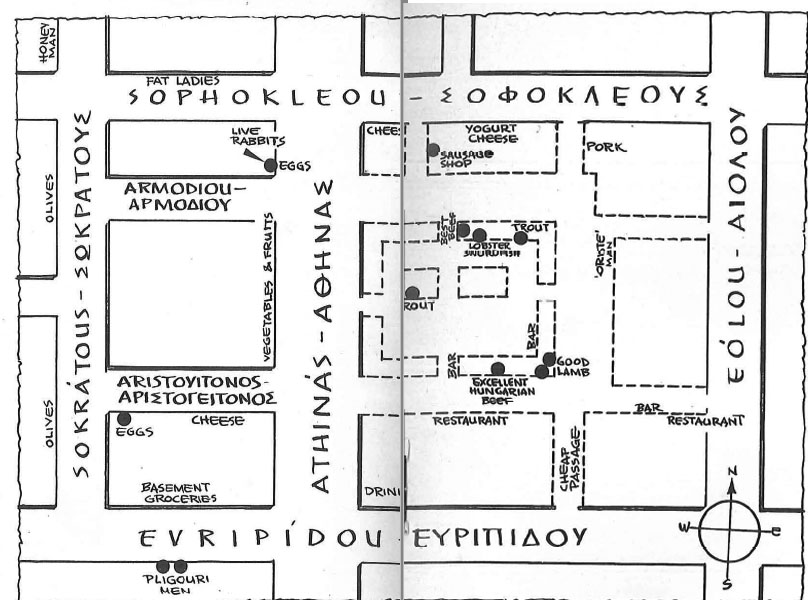
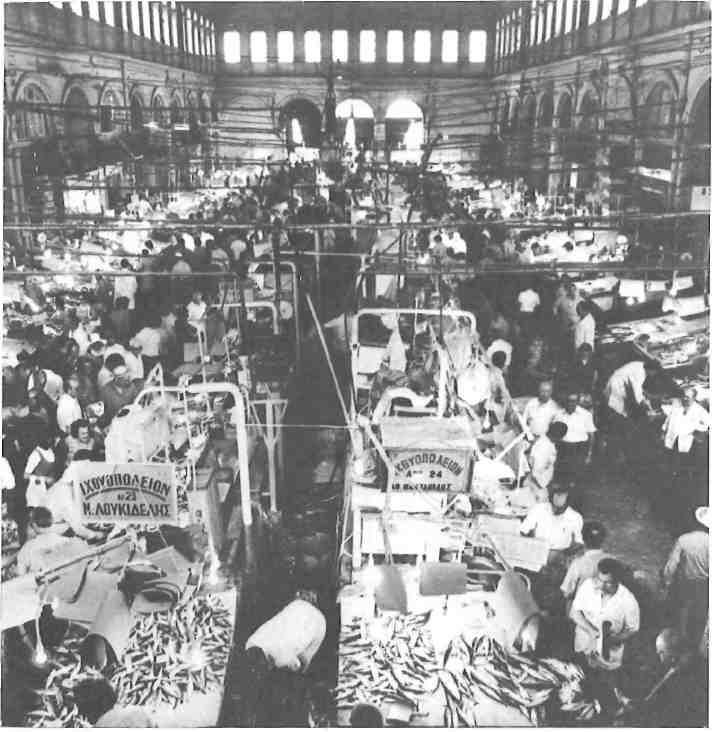
Major market areas in New York, London and Paris are well known but rapidly disappearing. In Athens, however, most of the central market place is intact and offers a wide variety of foodstuffs and household supplies. This basic area is on either side of Athinas Street in the rough rectangle formed by Sophokleous and Evripidou Streets on the north and south, and by Sokratous and Eolou (Aiolou) on the west and east. The focal point is the Central Meat Market, located in a late nineteenth-century roofed building on the east side of Athinas Street facing the remains of the vegetable market on the other side of the old Varvakion which burned down in 1944.
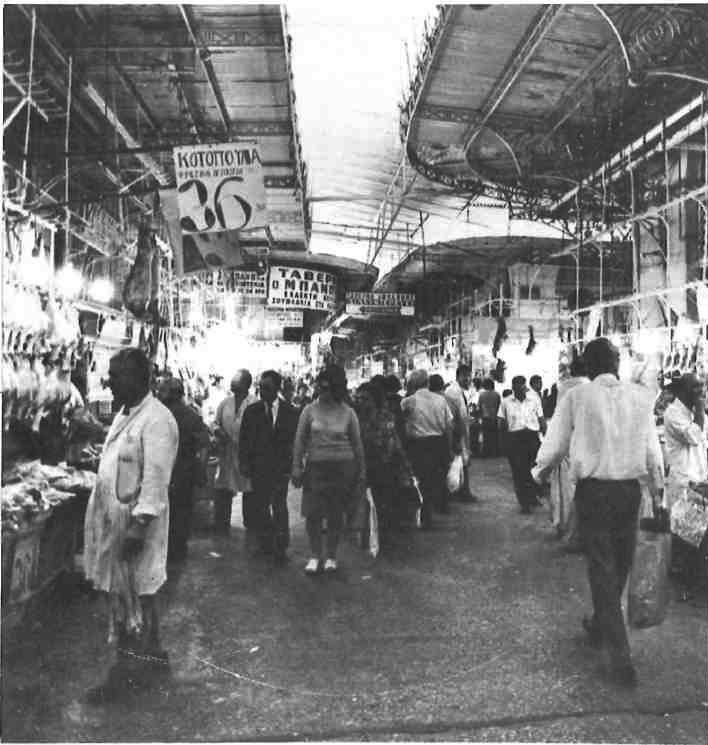
A central market area was included in King Otho’s master plan for the city’s development but it was not built until 1887 after the earlier one burned down. That earlier market was the Roman Agora, so it’s not exactly a new idea! Today the Central Meat Market building takes up most of the square formed by Sophokleous and Evripidou, and Athinas and Eolou. Its actual exterior is in places difficult to identify since all but the Athinas Street facade is masked by later buildings which cluster around it. The market area within these boundaries, however, is another matter.
It is actually a hollow square covered by a roof. The square is bounded by two major corridors which run from east to west and are continuations of two small streets, Armodiou and Aristoyitonos, and a long north-south corridor (running parallel to Eolou) and the market’s facade on Athinas Street. Entrances can be found at both ends of the east-west corridors (the eastern ones are rather obscure), at both ends of the north-south corridor, and in the middle of Sophokleous Street.
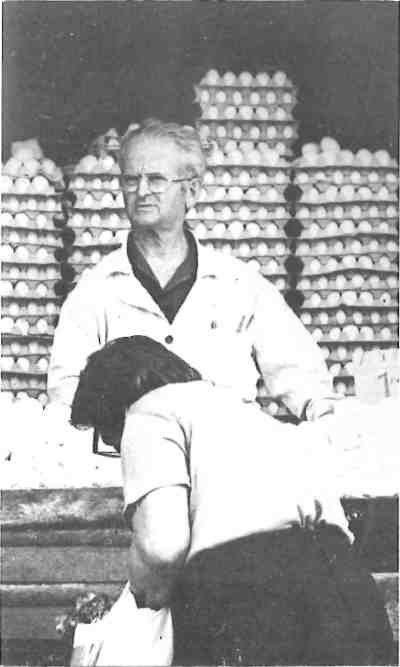
Let’s walk through the market starting from the entrance at Armodiou and Athinas. On your left will be a coffee store. As you enter, a seemingly endless array of meat and chicken will assail your eyes (and your nose, too, if you go after 11:30 a.m. in the summer) for this market houses several score of competing butchers all of whom are constantly, and vociferously, proclaiming the superiority and quality of their wares. This Armodiou corridor contains mostly chicken and lamb. Some of the very best beef in the market, however, is to be found in a little passage on your right. (The same passage leads to the fish.) Fresh and frozen meat are available with the general exception of chicken. Frozen meat comes from a variety of countries: Australia, New Zealand, Hungary, Argentina and East Germany, to name a few. New Zealand lamb and Hungarian beef are both of very high quality and seem to have less waste than their local counterparts.
Returning to the Armodiou corridor and taking the first left (which leads to Sophokleous) you will come upon a sausage shop to your right. This is, for my money, the best in Athens. I just don’t like many locally made sausages and cold cuts but I find those sold in this shop to be all good — and I have tried at least fifteen varieties.
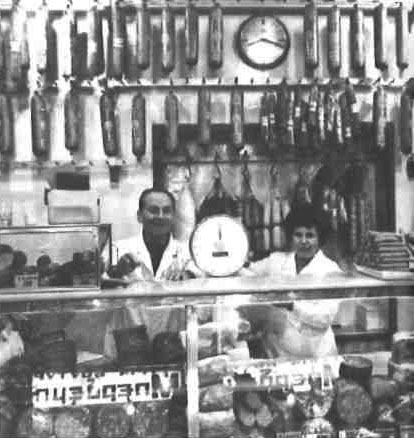
which may surpass all others in both variety
and quality.
Returning once more to the Armodiou corridor, continue along until you come to the ‘malevolent oriste man’. This gentleman, who greets you with ‘Oriste’, sells chickens (good chicken, too) in such a manner that the moment he catches your eye, you’ve bought one! Therefore, turn quickly down the north-south corridor and come to a halt. Behind you, at the exit to Sophokleous Street, are to be found the best pork sellers. Ahead of you is an array of the usual butchers and some good chicken shops. At the end of the passage, where it enters Evripidou, is the bargain area where you will find frozen mutton and the like at ridiculously low prices. Turn right into the Aristoyitonos (east-west) corridor and you will find at the corner, on your right, a very good stall for frozen beef and lamb. Beyond this, also on the right, is an even better place for Hungarian beef.
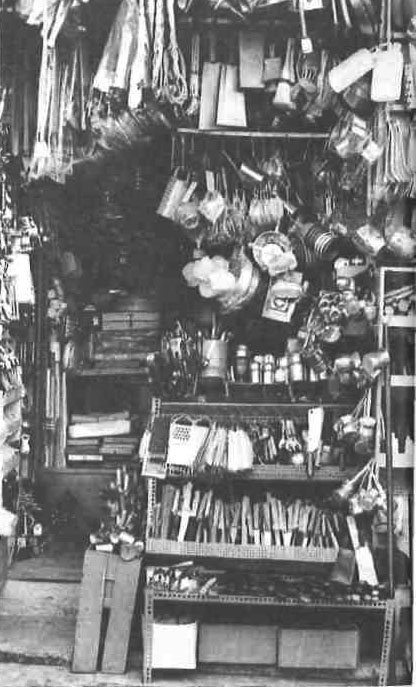
this store to find the odds and ends on your
shopping list.
A good reason to buy frozen meat is that it comes in recognizable cuts: rib roasts, steaks, etc., rather than the usual shapes found locally which are determined solely by the past. Until very recently the only means available for cooking meat were open fires for grilling or the local baker’s oven where meat was cooked slowly. Cuts not suitable for these purposes were not used. Another good reason to buy frozen meat is that the quality is exceptionally high.
Continuing along the Aristoyitonos corridor you will come to a little passage on your right. Go through it as it leads to the fish market located in the hollow centre of the square. If you like draft beer and mezes, you may be tempted to linger and have some at a nice little bar in this passage. The ambience is not quite what one has always wanted: there is an old knife sharpener from Oregon, a sweet little lady selling chickens and an ‘appetising’ display of hearts, lungs, and varia. If you like fish, however, this part of the market will be the highlight of your tour. Almost every imaginable kind of fresh and frozen fish can be found here at prices which are often remarkably cheap. Lobster (astakos), live crab (kavouri), crayfish (karavides), swordfish (xiphias), shrimp (garides), and fresh trout (pestropha), are just a few of the many varieties. Octopus (oktapodi), always frozen, squid (kalamari) and shellfish (hopefully not from the Piraeus area) are also available. Should you want to make bouillabaisse all the ingredients are here including the Christopsaro, or John Dory, which can be recognized by its huge head and greenish body which sports a large black spot on each side. There are also all kinds of scorpion fish which look like armoured dinosaurs but are a must in good fish soups.
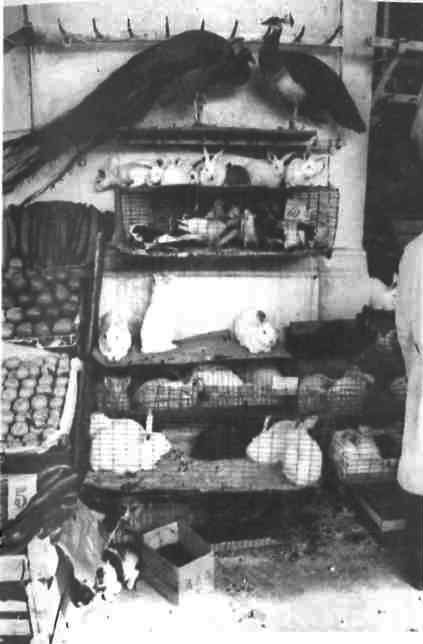
live assortment of rabbits, peacocks and
chickens. You may explain to your children
that they are being sold as pets.
The Central market is not only wonderful to photograph, it is also a great place to shop. There are, however, a few rules to remember. Go early in the day, since you will not want anything that has been standing around too long. Do not buy anything that does not look good to you. Meat should not be turning black at the edges from prolonged exposure to air nor should chickens have prominent dry spots. Fish should never have sunken eyes or a nasty odour. The best pork should be pale in colour and the best chickens should have dark, rich-looking livers (which is why they’re on display for you to see). Don’t forget to ask for kotopoulo when you want chicken; kotes and kokkoria are for boiling and stewing. Do not be upset if the butcher includes a small piece of bone with the frozen meat when he weighs it, since it is permitted by law. All frozen meat, regardless of cut, costs the same for each type. For example, chops, legs and breasts of lamb are the same price per kilo.
Having bought your meat and fish, you should explore the rest of the area. Sophokleous and Evripidou, on either side of the meat market, are lined with cheese shops. Pick any one that seems to have a nice display — the quality is always high and the salesmen get a terrific kick out of foreigners, often serving them before scores of protesting regular customers.
Should you be interested in liquor, you can buy very nice ouzo and very bad brandy from Mytilene, sold by a variety of little men throughout the market area. You can also go to the northwest corner of Athinas and Evripidou and enter a little wine shop where you may have ‘tastes’ for very low prices. You may never leave.
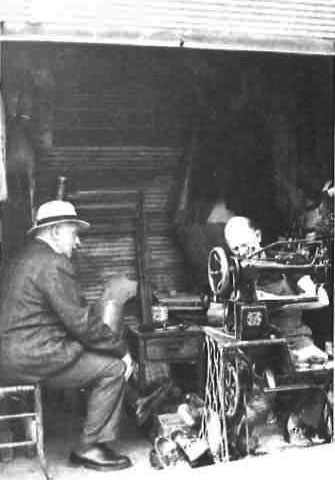
repaired as you wait.
Across Athinas Street is the main vegetable market where much of the produce is of very high quality. Sometimes the sheer number of fruits and vegetables is overwhelming. If you take along your children — a fine idea on any day other than Saturday when the place is packed and they are liable to be stepped on — be sure to visit the remarkable egg shop at the northwest corner of Armodiou and Athinas. There you will find all kinds of live rabbits, chickens, pigeons and ducks. ‘Of course, they’re being sold as pets,’ you may tell the children. The shop sometimes has puppies and peacocks which I certainly hope are for pets! Should you buy eggs (I’ve only gotten one bad one out of about 200 so don’t worry) make sure they put lots of sawdust in the bag so that they are properly cushioned.
Sokratous Street, at the back of the vegetable market, contains numerous spice shops, a honey shop (bring your own bottle and you must buy at least a kilo), and many little groceries and shops selling all manner of plastic and paper goods. They sell toilet paper and the like in bulk. West of Athinas, Sophokleous Street is lined by strictly wholesale shops and by ‘Ladies’ of dubious mien all very obese and wearing short skirts and lounging in doorways. Given the location, I think these Fat Ladies, too, must be sold by the kilo. The connoisseur had best look elsewhere.
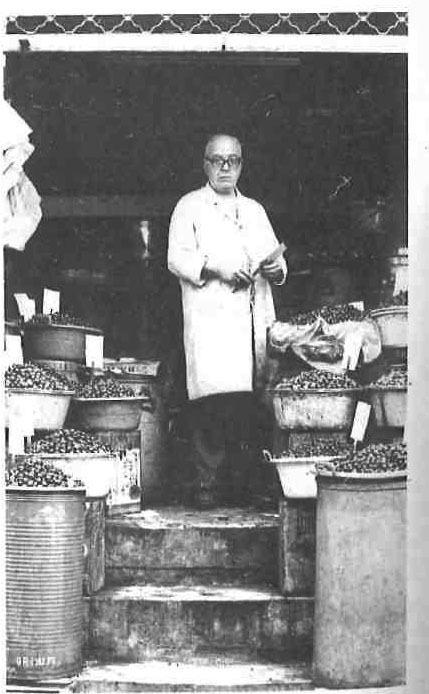
Before you leave the area, walk down Sokratous to Evripidou and turn left. All the olive and pickle shops you will pass sell only in kilo lots and you may not want that much. They are often remarkably cheap, however. Evripidou is packed with little underground groceries which sell all kinds of dried vegetables, beans, rice and the like. They are so much less expensive than packaged ones that the difference is often as much as twenty drachmas per kilo. Some of the beans are so colorful that you may buy them even if you have no idea of what they are or what to do with them! If worst comes to worst, you may put them in glass jars and use them as decoration in your kitchen! Some of the best beans to buy are mavromatika (black eyed peas), fakes (lentils), and barbounia (can be used for chili). At two sausage shops (right next to each other on the south side of the street) you can buy pligouri (bulgur — which is parched cracked wheat). They are the only two shops in Athens which sell it, as far as I know, and it’s really delicious as well as nutritious. It may be prepared in the same way as rice or other groats. Elsewhere in the magazine I have some suggestions for the preparation of pligouri.
If you’ve gone this far and bought some of everything, you are probably carrying, in those plastic bags conveniently sold all over the area, at least fifteen kilos of food! Now go home quickly before you buy anything else!
Remember you have just done what Athenians were doing at the turn of the century. The only difference is the relative absence of politics: in the first half of the century the market was a hot bed of radical activity and your purchases would more than likely have been wrapped in a tract that you would read when you got home. Now everything seems to be wrapped in sheets of Athens News, To Vima, and other newspapers. We hope, however, that you won’t find your fish wrapped in The Athenian. If it is, turn to the cooking page to find out what to do with the fish.







